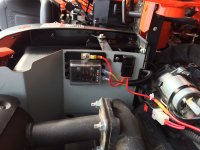Whether the circuit is hot all the time or not doesn't change the use or need for a relay. And in this particular application we are most certainly talking about a switched situation. The switch being the controller for the 3rd function.
Without a relay = The power required to activate the 3rd function is obtained and ran thru the 3rd function switch to the solenoid.
With a relay = Low amp power is obtained from wherever you choose. That low amp power goes thru the 3rd function switch to the relay. High amp power required to run the 3rd function solenoid is obtained from an adequate source, in this case I'd go to the battery, and provided to the relay. When the 3rd function switch is activated power goes to the relay and makes the high amp connection. At that time your high amp power is conveyed thru the relay and to the 3rd function solenoid. Thus all the load is carried by the high amp circuit and the relay.
Sounds confusing but it's actually not.


